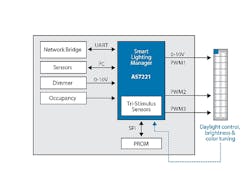IoT-focused ams announces a light sensor aligned with the human visual systems that is focused on tunable SSL systems and that also integrates the PWM signal generators needed to drive three LED strings.
Austria-based ams AG has announced the AS7221 smart lighting manager component that integrates a tristimulus sensor that can enable precise control of multi-string LED light engines in tunable luminaire developments. The component can also link to other sensors, supports network connectivity, and includes three pulsewidth modulation (PWM) signal generators that drive LED strings in tunable luminaire developments while also enabling smart lighting capabilities for Internet of Things (IoT) applications.
Interested in articles & announcements on tunable-white SSL?
The tristimulus sensors are the element of the light manager that truly set the component apart. Indeed, the sensors are designed based on the tristimulus or red, green, blue (RGB) color space in the CIE (International Commission on Illumination) 1931 color space that remains the basis of much of the color science that underlies lighting products. For more information on color science, see the exhaustive four-part series of article we published on the topic a few years back.
The sensor serves the purpose of feedback in a luminaire development, enabling fine tuning of the PWM outputs and precise color output in multi-string, LED-based designs. For example, developers might use the sensor to ensure that a tunable-white lighting product exactly matches the black body locus (BBL) on the CIE diagram. Or perhaps a developer might purposefully target white points below the BBL based on the knowledge that some people have expressed preference for such whites.
Sensor developer ams has designed a tristimulus (RGB) sensor-based light manager that provides tunable-white capability for LED luminaires.
Certainly there will be many tunable luminaire designs on the market that don’t include the luxury of such a sensor. Instead, a product design can rely on detailed LED operating data gained from LM-80 testing to deliver relatively precise white points. For example, look at the Cree TrueWhite technology platform. Some of the TrueWhite products use what's called blue-shifted yellow (BSY) plus red LEDs to deliver warm CCTs and high CRI with no efficacy penalty. When Cree first shipped such a product back in 2011, the luminaires included a sensor to keep the BSY and red LEDs balanced because the BSY and red components featured quite different lumen-depreciation and color-shift rates. Later, however, Cree was able to use operating data gathered for each LED type to programmatically compensate for the shifts over time without a sensor present.
We asked ams why luminaire developers wouldn't pursue a similar strategy with tunable products today as opposed to adding a sensor. Tom Griffiths, senior marketing manager at ams, identified several reasons that the sensor would be a better approach starting with the fact that most luminaire developers desire the freedom to change the LEDs they use in luminaires as prices drop or LED performance improves. Griffiths said the sensor would enable a product to easily accommodate an LED change and in fact even allow a luminaire manufacturer to buy LEDs across a broader set of bins, translating to lower-cost LEDs. Moreover, the ams component is priced in the $3.00 range and includes the other features such as the aforementioned PWM generators in addition to the sensor.
Related article: Integrating the Internet of Awareness into our smart SSL systems
Indeed, the AS7221 is intended to form the heart of a tunable luminaire. It's designed to directly support the ams TSL4531 ambient light sensor for daylight harvesting. Other sensors can be connected to the I2C interface. An integrated UART provides connectivity to a network. And the component includes a 0–10V dimmer input and can optionally output a 0–10V signal via one of the PWM channels.
"The next generation of lighting will be defined by three key characteristics: controllability, adaptation, and connected architectures," said Griffiths. "Our new family of smart lighting managers meet those criteria. With this latest entry, we are addressing the luminaire manufacturers’ critical time-to-market challenge for developing and deploying a spectrally tunable luminaire that is cost-effective, accurate, and which smoothly integrates into the Internet of Things."






